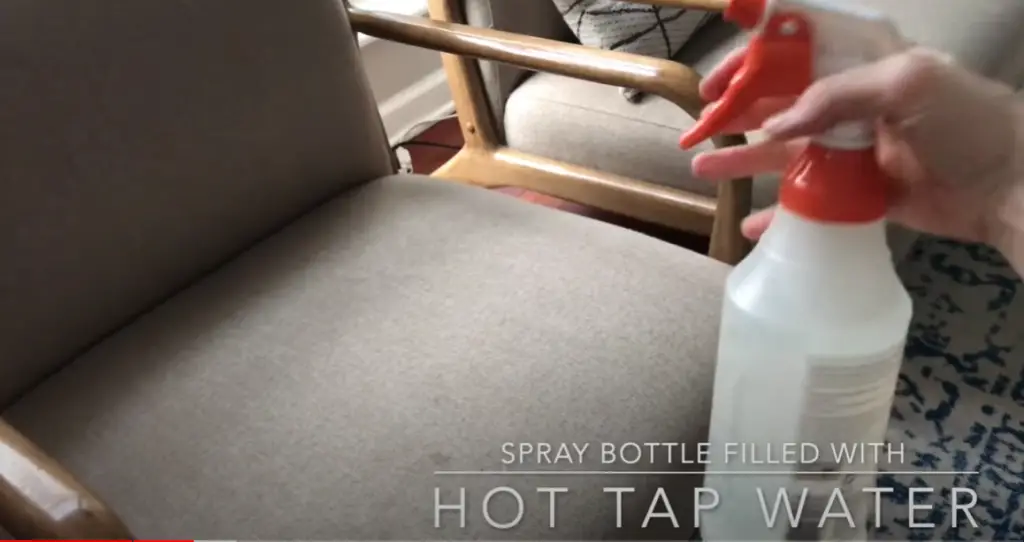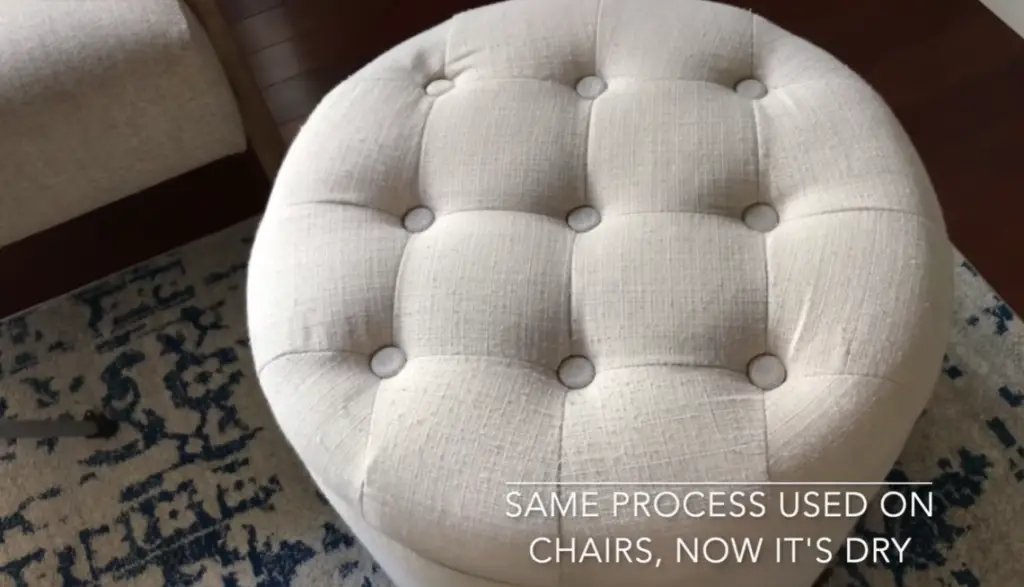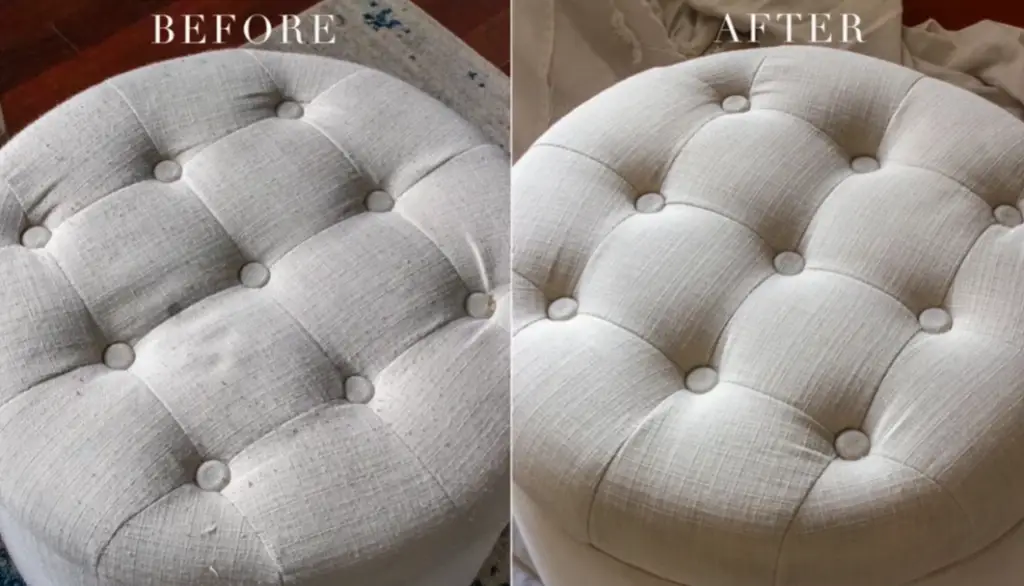How to Clean Upholstery Chairs Without a Machine by vacuuming and spot-cleaning stains using a mix of vinegar, dish soap, and water. Use a soft brush and clean towel for the process.
Maintaining the pristine condition of upholstery chairs involves a gentle yet effective cleaning routine that eschews the need for heavy machinery. Over time, chairs accumulate dust, spills, and various stains, necessitating careful upkeep to extend their life and appearance. Opting for a manual approach not only saves on energy costs but also allows for targeted treatment of delicate fabrics.
This introductory guide provides essential steps to preserve the integrity of your upholstery using common household items, ensuring your furniture remains a comfortable and clean addition to your living space. Embracing this method can revive dingy chairs, transforming them into fresh and inviting pieces without the hassle of complex equipment.

Introduction To Upholstery Cleaning
Think of your favorite spot to unwind, and chances are it involves an upholstered chair. Whether reading a book or catching up on your favorite series, keeping that cozy nook in pristine condition is a must. Welcome to the world of upholstery cleaning—sans the heavy machinery.
Understanding Fabrics And Materials
Upholstery comes in various textures and materials. Identifying your chair’s fabric is the first step. This knowledge determines the cleaning method you use. Common types include natural fibers, synthetics, leather, and vinyl. A simple label check can save your chair from potential damage.
| Fabric Type | Characteristics | Cleaning Method |
|---|---|---|
| Natural Fibers | Delicate, may fade | Gentle, drying fast |
| Synthetics | Durable, resists stains | Mild detergent, water |
| Leather | Ages with grace | Specialized cleaner |
| Vinyl | Easy to maintain | Soap solution, rinse well |
Benefits Of Regular Upholstery Maintenance
- Extends furniture life: Cleaning adds years to your chairs
- Enhances appearance: Keeps fabric looking fresh
- Improves air quality: Reduces allergens and dust
- Prevents damage: Stops spills becoming stubborn stains

Preparing The Upholstery Chair For Cleaning
Preparing the Upholstery Chair for Cleaning begins with a few simple steps. Without the use of a machine, a bit of elbow grease and the right approach can make a world of difference. Taking the time to properly prepare your upholstery chair ensures a more effective and safe cleaning process.
Clearing Surface Debris
Before tackling any stains or spots, start with removing loose particles that rest on the upholstery surface. Use a soft brush or a dry microfiber cloth to gently sweep away dirt, dust, and crumbs. For pet hair, a lint roller or tape wrapped around your hand can lift stubborn strands. This step ensures that when you move onto deeper cleaning, you’re not simply pushing around or grinding in the debris.
Determining Your Fabric Type And Cleaning Code
- Check the Manufacturer’s Label: Find the cleaning code on your chair’s label to understand what cleaning solutions are safe to use.
- W, S, SW or X: These codes indicate whether water-based cleaners (W), solvent-based cleaners (S), a combination of both (SW), or a vacuum only (X), should be used.
- Perform a Spot Test: Choose an inconspicuous area on the chair to test your chosen cleaner, ensuring no discoloration or damage occurs.
If your chair lacks a cleaning code, opt for mild soap and water for most fabric types, but always spot test first.
Spot Cleaning Techniques
Keeping upholstery chairs clean without a machine is simple. The right spot cleaning techniques make a big difference. Gentle, yet effective methods can protect the fabric. This ensures longevity and maintains appearance.
Identifying Common Stains
First, know what you’re dealing with. Different stains need different cleaners. Here’s how to identify common ones:
- Food Stains: Usually leave a discolored area.
- Oil and Grease: Create spots that darken fabric.
- Pet Stains: Might have an odor and discoloration.
- Ink: Leave sharp, distinct marks.
Homemade Spot Cleaners And Application Methods
Homemade cleaners can be just as effective as store-bought ones. They are often safer for your fabric. Below are some proven cleaners and how to apply them:
| Type of Cleaner | How to Make | Application Method |
|---|---|---|
| Vinegar Solution | Mix equal parts vinegar and water. | Blot stain gently, don’t rub. |
| Baking Soda Paste | Add water to baking soda until it forms a paste. | Apply to stain, let sit, then vacuum. |
| Mild Detergent Mix | Combine a teaspoon of dish soap with a cup of warm water. | Use a cloth to apply, then blot dry. |
| Alcohol or Spirits | Rubbing alcohol or clear spirits. | Dab the stain, let air dry. |
Deep Cleaning Without A Machine
Deep Cleaning Without a Machine: Sometimes, the soft, inviting cushions of an upholstery chair catch unpleasant spills and odors. Even without the power of a cleaning machine, giving those beloved chairs a thorough cleanse can be simple and effective. Discover methods to transform your chairs from dingy to dazzling, using easy-to-find materials and a bit of elbow grease.
Choosing The Right Cleaning Solutions
Selecting the appropriate cleaner is crucial for maintaining the fabric’s integrity. Start by checking the manufacturer’s label. It guides you on safe cleaners to use.
- W: Water-based cleaners
- S: Solvent-based cleaners only
- WS: Both water and solvent cleaners
- X: Professional cleaning recommended
For a DIY solution, mix gentle dish soap with warm water. A vinegar and water blend works wonders for odors. For tougher stains, consider baking soda or an upholstery-specific cleaner.
Hand-washing Methods And Best Practices
Hand-washing upholstery calls for a gentle touch and patience. Use the following steps:
- Test the solution on a hidden spot.
- Remove loose dirt with a vacuum.
- Dab the cleaner with a microfiber cloth.
- Gently rub to treat stains and dirt.
- Rinse with a damp cloth, no soaking.
- Blot with a dry towel.
- Air dry completely before use.
Do not oversaturate the fabric. It may lead to water stains or mold. Also, avoid harsh scrubbing. It can damage fibers.
By sticking to these guidelines, you ensure a fresh, revitalized chair, enhancing your living space’s beauty and extending the life of your furniture.
Drying And Protecting The Upholstery
After a thorough hand wash, drying and protecting your upholstery is key. Proper drying prevents mold. A good fabric protector keeps stains away. Learn effective air-drying techniques and apply fabric protectors easily.
Effective Air-drying Techniques
Dry upholstery plays a crucial role in maintaining its life.
- Open windows to create airflow.
- Switch on fans to speed up drying.
- Pat down with dry towels to absorb moisture.
- Let the fabric breath; avoid sitting until fully dry.
- Keep direct sunlight away to avoid fading.
Boldly apply these methods for a quick dry.
Applying Fabric Protectors
Once dry, protect with fabric protectors. A simple guide:
- Choose a protector suitable for your upholstery type.
- Ventilate the space; open windows and doors.
- Test on a small hidden area first.
- Spray evenly, holding the can at a safe distance.
- Let it dry completely before use.
Keep your chairs clean longer with protectors.
Eco-friendly Upholstery Cleaning Options
Eco-Friendly Upholstery Cleaning Options provide a gentle yet effective approach to keeping furniture looking fresh. Ditching the machine for hands-on methods preserves your upholstery’s integrity. Focus on natural substances and sustainable practices for a spotless outcome.
Natural Cleaning Agents
Transform your home into a green-cleaning zone with everyday items from your pantry. Here’s a quick list:
- White Vinegar: An eco-warrior, great for loosening stains.
- Baking Soda: Lifts odors and lightens dark spots.
- Lemon Juice: Naturals bleach, adding a fresh scent.
- Castile Soap: Gentle on fabrics, potent on dirt.
Mix these ingredients with water for an all-purpose upholstery spray. Test it on a small area first. Lightly spray on affected areas and blot with a soft cloth.
Maintaining Upholstery With Sustainable Practices
Adopt sustainable habits to prolong your furniture’s life:
- Vacuum Regularly: Use a handheld vacuum to remove dust and crumbs.
- Spot Clean Spills: Act quickly to prevent deep stains.
- Rotate Cushions: Even wear extends durability.
- Avoid Direct Sunlight: Protects against fading.
Additionally, use machine-washable covers for easy cleaning and minimal environmental impact.
Deodorizing Upholstered Chairs
Keeping your upholstery fresh is as important as keeping it clean. Over time, chairs can develop a less-than-pleasant scent. Let’s explore some easy solutions to deodorize your upholstered chairs without the need for a machine.
Using Household Items To Combat Odors
Vinegar and Baking Soda — your secret weapons against odors. They absorb and neutralize even the toughest smells.
-
Mix equal parts white vinegar and water in a spray bottle.
-
Lightly mist the fabric, careful not to soak it.
-
Sprinkle baking soda generously over damp areas.
-
Let it sit for at least 15 minutes or overnight for stronger odors.
-
Vacuum the baking soda. Freshness restored!
Lemon Freshness Hack:
Add lemon juice to the vinegar mix for a citrusy scent.
Routine Freshening Tips
Schedule a weekly deodorizing session to maintain freshness.
-
Avoid eating on chairs to minimize food odors.
-
Regular vacuuming removes dust and crumbs that can cause smells.
-
Open windows often. Let fresh air circulate through the fabric.
-
Consider slipcovers if you have pets. They catch fur and can be washed easily.
-
Sunlight is a natural deodorizer. Let your furniture bask occasionally.
By following these simple practices, your chairs will not only look clean, but they will also smell wonderfully fresh!

Dealing With Tough Upholstery Challenges
Dealing with tough upholstery challenges can seem daunting. From spilled wine to stubborn pet hair, upholstery can suffer from a variety of stains and wear over time. But don’t worry. With some simple, machine-free methods, those upholstered chairs can look refreshed and vibrant once more. Here’s how to tackle things head-on.
Handling Stubborn Stains
Attack stains as soon as they happen. The quicker a stain is addressed, the less time it has to set in. For food or liquid spills:
- Blot, don’t rub, the stain with a clean, white cloth.
- Mix a solution of mild soap and cold water.
- Apply the soap solution with a sponge, then blot again.
- Rinse with a clean, damp cloth and dry thoroughly.
For oil or grease stains, sprinkle baking soda or cornstarch on the area. Let it sit for 20 minutes to absorb the oil, then vacuum it up.
Revitalizing Old And Worn Upholstery
To give your chairs a new lease of life, try this:
| Material | Cleaning Solution | Instructions |
|---|---|---|
| Fabric | Vinegar and water mix | Lightly spritz and wipe with a microfiber cloth. |
| Leather | Equal parts vinegar and natural oil | Apply gently with a soft cloth to condition the leather. |
| Suede | Dry cleaning solvent | Use a soft-bristled brush to lift the nap and remove debris. |
Vacuum regularly with an upholstery brush attachment to prevent dirt from becoming embedded. For fraying or thinning fabric, consider a professional upholstery protector to extend its life.
Safety Precautions During Cleaning
Keeping your upholstery fresh and clean doesn’t mean you have to bring in heavy machinery. But safety should always come first.
Using Non-toxic Substances
Choose safe cleaners for your health and the environment.
- Vinegar – A natural disinfectant, gentle on most fabrics
- Baking soda – Great for odor removal
- Mild dish soap – A soft cleaner for delicate upholstery
Always spot test in a hidden area before applying to the entire chair.
Preventing Color Fading And Material Damage
To maintain bright colors and prevent damage:
| Do’s | Don’ts |
|---|---|
| Test cleaners for colorfastness | Use harsh chemicals like bleach |
| Blot stains; don’t rub | Over-wet the fabric |
| Use soft cleaning cloths | Expose to prolonged sunlight after cleaning |
Follow fabric care labels for specific guidelines.
Tools And Materials Checklist
Preparing to tackle the challenge of cleaning upholstery chairs by hand? Begin with the right tools and materials. A checklist ensures nothing gets overlooked. Let’s dive into the essential items you’ll need and explore some clever substitutes for common commercial equipment.
Essential Items For Upholstery Cleaning
Gather these items to effectively clean upholstery without a machine:
- Vacuum cleaner with brush attachment – Removes dust and loose debris.
- Bucket – Mixes your cleaning solution.
- Soft-bristled brush – Gently loosens stains.
- Cleaning cloths – Blots and wipes fabric.
- Mild dish soap – Acts as a gentle cleaning agent.
- Baking soda – Natural odor eliminator.
- Distilled water – Prevents water stains on certain fabrics.
- Spray bottle – Applies the cleaning solution evenly.
- White vinegar – Helps with tough stains and odors.
Substitutes For Commercial Cleaning Equipment
No commercial-grade cleaner? No problem. Try these household alternatives:
| Commercial Equipment | DIY Substitute |
|---|---|
| Upholstery Steam Cleaner | Iron with steaming function |
| Upholstery Shampoo Machine | Homemade solution of vinegar, dish soap, and water |
| Commercial Stain Remover | Paste of baking soda and distilled water |
| Ozone Deodorizer | Bowl of vinegar left out overnight |
Adapting these simple tools and materials can lead to beautifully clean upholstery chairs. Get started and see the transformation!
Maintenance: Keeping Your Upholstery Clean Longer
Preserving the fresh, welcoming look of your upholstered chairs doesn’t have to be a chore. Little steps taken regularly can make a big impact. Upholstery is like skin; it requires care to remain vibrant and clean. Dive into these easy daily practices and periodic cleaning strategies!
Daily Habits To Avoid Stains And Dirt
- Immediate Spot Cleaning: Address spills right away to prevent stains.
- Use Throw Blankets: Protect seating surfaces with washable covers.
- Ban Food and Drinks: Keep edibles away to avoid accidental spills.
- Regular Vacuuming: Use a handheld vacuum to nip dust and crumbs in the bud.
Periodical Cleaning Schedules
Maintain your chairs with a structured cleaning plan. Here’s a simple guide:
| Frequency | Cleaning Task |
|---|---|
| Weekly | Vacuum and wipe down with a damp cloth. |
| Monthly | Deep clean fabric with mild detergent. |
| Seasonally | Apply fabric protector to repel dirt. |
Note: Always follow the manufacturer’s instructions for specific fabric care.
Conclusion: Embrace The Clean And Fresh Look
Conclusion: Embrace the Clean and Fresh Look.
Recap Of Key Cleaning Strategies
We dove into various ways to keep upholstery chairs pristine without the need for a machine. Let’s review the highlights:
- Vacuuming: Start by removing debris with a handheld vacuum or brush attachment.
- Spot Cleaning: Tackle spills immediately with a gentle cleanser and a soft cloth.
- Baking Soda: Use it for odor removal and light cleaning, then vacuum it away.
- Mild Detergent Solution: Perfect for tackling tougher stains gently but effectively.
- Drying: Pat dry with a towel and let air dry completely for a fresh feel.
The Importance Of Upholstery Care In Home Aesthetics
Clean upholstery is a cornerstone of a beautiful home. Well-maintained chairs:
- Enhance Appearance: They look inviting and new.
- Improve Lifespan: Regular care extends fabric life.
- Promote Health: They become free of allergens and dirt.
- Boost Comfort: A fresh chair offers better relaxation.
Care for your upholstery chairs, and they will remain the stars of your living space.
Frequently Asked Questions For How To Clean Upholstery Chairs Without A Machine
Can I Clean Upholstery Without A Machine?
Yes, you can effectively clean upholstery without a machine using simple household items. A mixture of dish soap, warm water, and a microfiber cloth can work wonders for light stains and general cleaning. Always test a small area first to ensure colorfastness.
What Diy Methods Work For Upholstery Cleaning?
DIY upholstery cleaning can be done with a solution of vinegar and water or rubbing alcohol. Apply the mixture with a spray bottle, then gently blot with a clean cloth. Baking soda can also be used for odors, sprinkling it on, and vacuuming off after a few hours.
How Often Should I Clean My Upholstery Chairs?
Upholstery chairs should ideally be spot-cleaned as spills occur and given a deeper clean every few months. Frequent light cleanings can maintain your chair’s appearance and prolong its life, while a seasonal deep clean can refresh the fabric and remove hidden dirt.
What’s The Best Stain Remover For Upholstery?
The best stain remover for upholstery depends on the type of stain. For general stains, a mixture of dish soap and water is effective. For tougher stains, a solution of white vinegar or rubbing alcohol can be better. Always test your cleaner on an inconspicuous spot first.
Conclusion
Keeping your upholstery chairs clean doesn’t require expensive equipment. With simple household items, you’ve got this covered. Embrace the ease of these methods and enjoy the fresh look of your furniture. For more DIY cleaning tips, stay tuned to our blog.
Your spotless home awaits!

